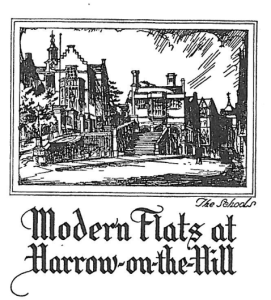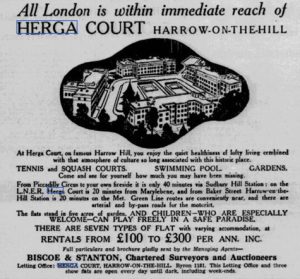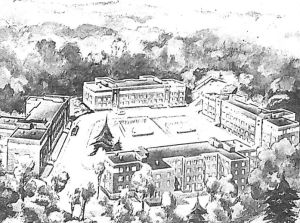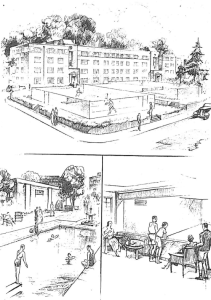History




Herga Court – a brief history
What’s in a name?
The name Herga can be traced back to the 8th Century when “Hearg” was the Saxon name given to a sanctuary or temple built high up on the hill – probably where St Mary’s Church now stands.
The spelling changed over time to become Herga, and when flats were built here in 1936, the decision was made to give the name to this plush new housing development situated on the slopes of the hill.
A grand manor house
Before Herga Court was built, old maps of the area dating to 1932 show there was a house in the grounds called Sudbury House. This was, it turns out, a grand manor house of some standing.
In April 1928, the Harrow Observer announced that the house was for sale at auction. It was described as an “attractive family residence in the best residential part of the district.”
Part of the house dated back to 1765 and it had three reception rooms, a lounge, hall, billiard room, 12 bed and dressing rooms, four bathrooms, an entrance lodge – still here today at the entrance to Herga Court – and two cottages. It had gardens, grass and hard tennis courts, shrubbery walks, a rose garden, an orchard and a paddock.
It’s not hard to see how the grounds of Herga Court could once have been part of this grand manor house.
Presumably the house was knocked down and the flats built in their place, although there is no mention of this in local newspapers of the time. Once the flats were built in1936, persuasive adverts were taken out in the London press to encourage people to move to these plush new homes
The healthiness of lofty living
One advert reads: “At Herga Court on famous Harrow on the Hill, you enjoy the quiet healthiness of lofty living, combined with the atmosphere of culture so long associated with this historic place. All London is within easy reach of Herga Court.”
The advert mentioned tennis courts, squash courts, a swimming pool (which was located in the rear gardens) and extensive gardens. It also trumpeted the Court’s easy commuter links – 40 minutes to Piccadilly Circus via Sudbury Hill station and 20 minutes to London Marylebone via Harrow-on-the-Hill.
Interestingly, the adverts also highlighted the community-feel of the Court, stating: “Children who are especially welcome can play freely here in a safe paradise.”
In 1936 there were seven types of flat available with rents ranging from £100 to £300 per year.
High class residents
You can get a flavour of the high social status the flats had in those days. In May 1941, there was a newspaper report of a wedding at St Mary’s Church.. It was between Mary, the only daughter of the late Brigadier GT Burney of The Gordon Highlanders and Mrs Burney of 15 Herga Court, Harrow-on-the-Hill, and Captain Robert I M Henderson, also of The Gordon Highlanders. These were clearly people of some status.
In January 1947, the Harrow Observer reported that another high-profile resident, Air Commodore G O Venn had been appointed to become president of the Wembley branch of the Royal Air Forces Association.
In 1947 the status of the flats is shown again with an advert placed by the owner of number 68 Herga Court, advertising for a live-in maid. In 1948 there was an advert for a live-in mother’s help!
Tragedy
As with any residence, Herga had its fair share of tragedy too. In an article in the Uxbridge and West Drayton Gazette of March 1940, a woman who was working for a shipping firm which had evacuated some of its employees to Herga Court – presumably because of bombing in central London – was described as having been found in a bathroom with her dressing gown on fire. She died later in hospital from burns. At the inquest, Miss Kitty Florence Dore, a shorthand-typist who lived at 60. Herga Court, said that at about 11.30 pm on Monday, February 19, she was in her bedroom when she heard a scream. She ran to the bathroom. where she saw the woman who was standing by the side of the bath, holding her hands above her head. The badly injured woman told her she had been switching off the heater when her clothes caught on fire. A verdict of ‘Accidental Death” was returned.
The shadow of war
Adverts for rented flats from the early 1940s show central heating was already available here – an early date for such a luxury – and that there were ARP shelters set up to guard against bombs.
Another impact of the war is clear from October 1941 when a woman called Annie Haselmere was ordered to pay a £1 fine for allowing a light to show from her Herga Court flat during an air-raid blackout.
One day during the war, a dozen incendiary bombs burned fiercely in Herga Court, but it wasn’t an air raid. It was in fact a fire-fighting demonstration of how these types of wartime bombs could be put out. The Harrow Observer gushed that it was “one of the most realistic most thrilling and most instructive demonstrations ever staged in Harrow”. The event organised by the Herga Court Tenants’ Association was given by Warrant Officer Stone of the RAF. Nearly 100 tenants turned out to surround the swimming pool which, when emptied of water, made perfect sunken stage for the demonstration. RAF experts handled live two-kilo incendiary bombs as though they were “indoor fireworks”, hurling them around and dowsing them with buckets of water to show how they could be put out
To inspire confidence, one of the women in the audience was encouraged to take hold of a fiercely-burning incendiary and to light her cigarette with it.
Amongst the high-profile Herga residents, in January 1947, Flight Lieutenant John Venn of Herga Court accompanied Lord Montgomery to Moscosw on a crucial post-war mission to act as an interpreter. He was only in his 20s at the time and had already acted as a liaison between Russian and Soviet forces when they met in Germany at the end of World War Two.
Scandals
As you’ expect of any London dwelling, the Court also saw its fair share of personal scandals. In a public notice in the Uxbridge and West Drayton Gazette of July 1948, one Alan Linter Jaggs of 75, Herga Court, wrote that: “I hereby expressly withdraw all and every authority which my wife Daisy Nellie Jaggs may have at any time either expressly or by implication or otherwise acquired to contract for me or in my name or as my agent or in any way to pledge my credit, and that I will not be responsible for her debts whensoever and howsoever incurred.” Simply put, it seems poor old Alan had been the victim of his spendthrift wife who had been stealing from him hook line and sinker.
The Daily Mirror of April 10, 1968, reported a case of adultery that had rocked the Court. It said that a couple who had married mainly through “sex attraction”, had been given their just desserts when the wife committed adultery.
In September 1949, Leslie Edward Sidney Treherne of Herga Court, a former director of the Prestige Bedding Company, of Carlton Avenue, East, Wembley Park. was fined £2OO at Wealdstone Court on Tuesday. He had pleaded guilty to being “knowingly concerned in the fraudulent evasion of the payment of purchase tax amounting to £265 35.”
The opulence of the place could also be a target for thieves. In February 1951, thieves removed ten feet of lead piping from outside the garages of Herga Court. The batteries were also stolen from two cars in the car park.
Stars of stage and screen
On a lighter note, in June 1960, the Harrow Observer reported on one James Booth, a star of stage and screen who lived at the Court. It said: “James Booth. one of the outstanding stars of the West End musical “Fings Ain’t Wot They Used T’Be” will soon be leaving his flat at Herga Court, Harrow, to make three pictures in Yugoslavia. Early next year his name will probably be in lights on Broadway. Yet five years ago he knew little or nothing about the theatre.”
In January 1963, the Harrow Observer mentioned another famous face from the Court. It reported that Cherry Lind who sang in the style the twenties and thirties, was set to sing on national radio.
It said: “The Plymouth-born singer comes from a musical family Her father, a violinist, was leader of the Bournemouth Municipal Orchestra and her mother was a classical singer. It is small wonder then that ! Cherry should inherit their talent. She was fortunate as a teenager to audition for the BBC and be accepted. Towards the end of the war she came to London and began touring as a musical comedy act. She also went on tours of Burma, India, Ceylon and Egypt and went to France shortly after D Day to entertain the troops.”
Subdivision
In April 1964 it was reported that planning permission been approved by the Minister of Housing and Local Government for the sub-division into two flats of each of 24 flats at Herga Court. 24 additional garages or parking spaces had to be provided to accommodate for this.
Permission was also given for the conversion of the existing basement stores in blocks 3 and 4 into three flats, subject to condition that a garage or parking space should be provided for each flat
Then in January 1972, Brikom Investments put forward plans to build 26 flats on top of the existing Herga Court. This was defeated in 1974 after residents complained about the impact it would have on the environment of Herga Court due to the space that would be lost for additional parking spaces. But change was afoot. In 1972 an article in the Harrow Observer stated that the Herga swimming pool had to be filled in when cracks appeared in the bottom.
The street where you live
In a fascinating article called: “The Street Where You Live” in the Harrow Observer of August 25, 1972, we find deep sea diver Peter Carr living at number 14 Herga Court. He was one of the first pioneers of “underwater television” – putting cameras underwater to film images. He lived here with Theo Dufton, an antique dealer who specialised in Chinese porcelain.
Scandalously for the day, the paper reported the couple lived together but were not married as both had been married before.
The same article described that Herga Court caretaker Mt Fred Gladdy who was well known locally for many years, lived at number 44 and was responsible for looking after the grounds of the Court. He had lived here with his wide Florence for 30 years. In the old days he used to have to hump 22 tonnes of coal a week into the boilers to heat the Court, but since the introduction of oil-fired heating his life had been made significantly easier. Fred described himself as a jack of all trades who could do almost any job at the Court, although he did have three cleaners to help him keep it looking nice.
Building up
In 1993, despite opposition from neighbours planners and councillors, the owners of Herga Court were finally given permission to build another storey on top of the flats. These plans had previously been defeated twice in the 1970s and 80s.
By 8 December 1994 the new roof-top flats were complete and on the market. Adverts for the new flats stated: “Exploiting their location they all have distant views over the surrounding area while looking down onto the centrally sited tennis court and garden provided for the use of the residents and their guests. There are additional communal gardens surrounding the development. Four flats are immediately on offer and all have a 76-year lease.”
By 1999, many more of the flats were being rented out and there were fewer leaseholders. This trend has continued since. A typical rental ad for a Herga flat in 1999 reads: “HERGA COURT HARROW ON THE HILL £185 pw Luxury 2 bed 2nd floor flat Gas ch 19′ fitted kitchen with washing machine and fridgefreezer 25′ lounge use of tennis courts Available immediately Unfurnished.”
